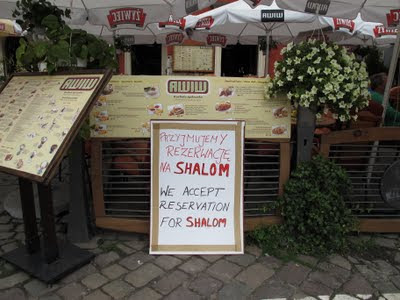My latest JTA story is about Oswiecim, the town outside of which Auschwitz was built.
 |
| Woman walks her baby in front of the Auschwitz Jewish Center. Photo (c) Ruth Ellen Gruber |
By Ruth Ellen Gruber
JTA, July 21, 2011 OSWIECIM, Poland (JTA) -- Can a town that exists in the shadow of death transform itself into a place of normalcy?
The question long has vexed Oswiecim, the town of 40,000 in southern Poland where the notorious Auschwitz death camp is located.
For decades, residents and city leaders have struggled to separate Oswiecim from Auschwitz and pull the town, its history and its cultural associations out from under the overwhelming black cloud of the death camp, which is now a memorial museum.
With only limited success to date, however, a new generation of town leaders is trying a different tack: bolstering Oswiecim as a vital local community, but also reaching out to connect with Auschwitz rather than disassociate from it.
"Ten or 15 years ago, many of us began thinking that the way to go was not to reject Auschwitz but to deal with it," said historian Artur Szyndler, 40, the director of research and education at the Auschwitz Jewish Center who grew up in Oswiecim under communism.
The town has adopted "City of Peace" as its official slogan. And for years a Catholic-run Dialogue and Prayer Center and a German-run International Youth Center near the camp have promoted reflection and reconciliation.
Downtown, the 10-year-old Auschwitz Jewish Center makes clear that before the Holocaust, Oswiecim had a majority Jewish population and was known widely by its Yiddish name, Oshpitzin. The center includes a Jewish museum and a functioning refurbished synagogue -- the only one in the city to survive. It runs study programs and serves as a meeting place for visiting groups.
And now the Oswiecim Life Festival, founded last year by Darek Maciborek, a nationally known radio DJ who was born and lives in Oswiecim, aims to use music and youth culture to fight anti-Semitism and racism.
"This place seems to be perfectly fitting for initiatives with a message of peace," Maciborek said. "A strong voice from this place is crucial."
The closing concert of this year's festival, held in June, included the Chasidic reggae star Matisyahu. He gave a midnight performance for a crowd of 10,000 in a rainswept stadium just a couple of miles from the notorious "Arbeit Macht Frei" ("work sets you free") gate of the death camp.
"It was an incredibly symbolic moment," Oswiecim City Council President Piotr Hertig told JTA. "It was a very important symbol that a religious Jew was performing at a festival in such a place."
Hertig said the new push to bolster Oswiecim and reach out more to the Auschwitz museum and its visitors is partly due to a generational shift in the town.
For a long time, most of Oswiecim's population consisted of thousands of newcomers from elsewhere in Poland who settled here after World War II. But today's community leaders increasingly include 30- and 40-somethings like Hertig and Maciberok who were born in Oswiecim and feel rooted here.
The town now has plans to go ahead with several projects that had been thwarted by outgoing Mayor Janusz Marszalek, who had particularly strained relations with the Auschwitz Memorial, according to Hertig. These include a new visitors' center for the memorial and a park on the riverbank just opposite Auschwitz that will be connected to the camp memorial by a foot bridge.
"This will be a very good place for people to come after visiting Auschwitz and Birkenau, where they can meditate, reflect and soothe their negative emotions," Hertig said.
Hertig said he hoped new programs and study visits developed with the Auschwitz memorial will encourage longer stays by visitors. Plans are in the works to build an upscale hotel in town and refurbish the main market square and other infrastructure.
"Auschwitz, on our outskirts, is the symbol of the greatest evil," Hertig said. "But at the same time we want to show to others that Oswiecim is a town with an 800-year history that wants to be a normal living town."
Located on the opposite side of the Sola River from the Auschwitz camp, Oswiecim has an old town center with a pleasant market square, several imposing churches, and a medieval castle and tower. In the modern part of town is a new shopping mall and state-of-the-art public library, as well as a big civic culture center that hosts a variety of events, including an annual Miss Oswiecim beauty pageant.
But few of the more than 1.2 million people who visit the Auschwitz camp each year ever set foot in Oswiecim or even know that the town exists.
"It is difficult to comprehend what it must be like to call this city your hometown," said Jody Manning, a doctoral student at Clark University in Worcester, Mass., who is writing a dissertation on life in Oswiecim and Dachau, Germany, also the site of a concentration camp.
Local residents long have resented that most outsiders make no distinction between their town and the death camp.
"People from outside are sometimes shocked. They ask how I can live in Auschwitz. But I don't -- I live in Oswiecim," said Gosia, a 30-year-old woman who works at the Catholic Dialogue Center. "This is Oswiecim, my hometown -- not Auschwitz!"
It remains to be seen whether the new push can help remove the stigma from Oswiecim and achieve a less strained modus vivendi with the death camp memorial. "People have the right to live normally, but I don't think they'll be able to disassociate from Auschwitz," said Stanislaw Krajewski, a leading Polish Jewish intellectual. "The best they can do is to use it in a constructive way; the very name Auschwitz has a magical power."











